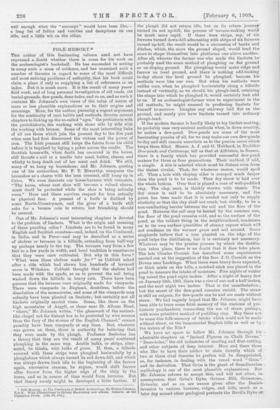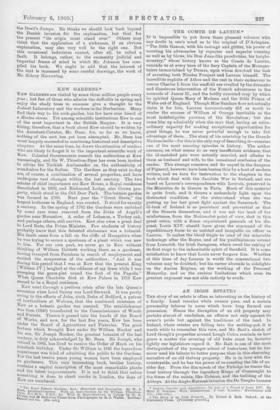FOLK-MEMORY.* Tins author of this fascinating volume need not have
expressed a doubt whether there is room for his work on the archaeologist's bookshelf. He has succeeded in setting in array such a mass of evidence, and has examined such a number of theories in regard to some of the most difficult and most enticing problems of antiquity, that his book could claim a place if only as supplying a list of references or an index. But it is much more. It is the result of many years' field work, and of long personal investigation of old roads, old burial-grounds, dew-ponds, dens-holes, and so on, and as such it contains Mr. Johnson's own views of the value of scores of more or less plausible explanations as to their origins and meanings. More, for the author, pursuing a cogent argument for the continuity of race habits and methods, devotes several chapters to linking up the so-called "ages," the prehistoric with the protohistoric, the working with stone side by side with the working with bronze. Some of the most interesting links of all are those which join the present day to the dim past when men had first discovered the virtues and the power of iron. The Irish peasant still keeps the fairies from his child before it is baptised by laying a poker across the cradle. The Scottish housewife, when death has occurred in the house, still thrusts a nail or a needle into meal, butter, cheese, and whisky to keep death out of her meat and drink. We still, many of no, hang up horseshoes; and Mr. Johnson, quoting one of his authorities, Mr. F. T. Elworthy, compares the horseshoe as a charm with the iron crescent, still hung up in Cairo. We even decorate our horse-harness with crescents. "The horse, whose cast shoe will become a valued charm, must itself be protected while the shoe is being actually worn." Here and there survives respect for iron actually in physical fear. A present of a knife is disliked by some North-Countrymen, and the giver of a knife still asks for a bronze coin in return, lest friendship should be severed.
One of Mr. Johnson's most interesting chapters is devoted to the problem of linchets. What is the origin and meaning of these puzzling relics ? Linchets are to be found in many English and Scottish counties—and, indeed, on the Continent, in India, and in Peru—and may be described as a series of shelves or terraces in a hillside, extending from half-way up perhaps nearly to the top. The terraces vary from a few feet to a few yards in width, and local tradition is unanimous that they were once cultivated. But why in this form ? "What were these shelves made for ?" as Cobbett asked after a ride which had shown him hundreds of terraced acres in Wiltshire. Cobbett thought that the shelves had been made with the spade, so as to prevent the soil being washed down the hillside in heavy rain. There have been guesses that the terraces were originally made for vineyards. There were vineyards in England, doubtless, before • the dissolution of the monasteries, and some of the vineyards may actually have been planted on linchets; but certainly not all linchets originally carried vines. Some, like those on the high mountains of Argyll, or those near St. Albans Head, "where," Mr. Johnson writes, "the glasswork of the ancient- like chapel not far distant has to be protected by wire screens from the fury of the storms of the English Channel," cannot possibly have been vineyards at any time. But, whatever was grown on them, there is authority for believing that they were made by the plough. Professor Seebohm has a theory that they are the result of many years' continued ploughing in the same way. Arable balks, or strips, alter- nated, he thinks, with balks of grass. If, then, a hillside covered with these strips were ploughed horizontally by a ploughshare which always turned its sod down-hill, and which was always drawn back idle to the beginning of the furrow again, successive seasons, he argues, would shift furrow after furrow from the higher edge of the strip to the lower, and so in course of time would form terraces. But that theory surely might be developed a little farther. If * Yolk-Memory ; or, no Continuity of British Archaeolooy, By Walter Johnson, r.a.s. With Illustrations by Sidney Harrowing and others. ()aeon': at the Clarondon Press. [125. GI not.] the plough did not return idle, but on its return journejr turned its sod up-bil], the process of terrace-making would be much more rapid. If there were strips, say, of six furrows turned down-hill alternating with strips of six furrows - turned up-hill, the result would be a succession of banks and ditches, which, the more the ground sloped, would tend the. more to shape themselves into platforms one above another. After all, whoever the farmer was who made the linchets, be- probably used the same method of ploughing on flat ground as on sloping ground. His ploughing would make ridge ancl furrow on level ground, and there is nothing odd-looking to-day about the level ground be ploughed, because his. methods were like our own. But when his methods were- unlike ours, when he ploughed horizontally along a hillside. instead of vertically, as we should, his plough-land, retaining' the shape into which he ploughed it, would certainly look odd to us. If an archaeologist-farmer were to experiment in the' old methods, he might succeed in producing linchets for himself to-morrow. Imagine any stairway laid flat on the- ground, and surely you have linchets turned into ordinary- plough-land.
If the modern farmer is hardly likely to try linchet-making,. be probably uses very ancient methods when, in down country,. he makes a dew-pond. Dew-ponds are some of the most fascinating puzzles of all, for we may make our own dew-ponds. to-day and still remain uncertain as to the precise cause which keeps them filled. Messrs. A. J. and G. Hubbard, in Neolithic- Dew-ponds and Cattleways, tell us that at Alfriston, in Sussex, there is a family which has provided successful dew-pond makers for three or four generations. Their method, if odcl,. is simple. A site is selected which must be distant even from the tiniest rivulet. That, for whatever reason, would spoil all. Then a hole with sloping sides is scooped much deeper. than the pond is to be made. Then dry straw is laid over the whole bottom. Over that is placed a coat of well-puddla clay. The clay, next, is thickly strewn with stones. The dry straw is said to be absolutely necessary, and the• guess has been made that it is needed not only to supply elasticity so that the clay shall not crack, but, chiefly, to be a. non-conducting barrier between the soil and the floor of the pond. However the soil may be heated by the summer sun,. the floor of the pond remains cold, and so the surface of the, pond, as the coldest thing in the neighbourhood, condenses. on to its own surface quantities of steamy vapour which will not condense on the warmer grass and soil around. Some shepherds believe that a tree planted on the edge of the- pond helps the distillation, but it is certainly not necessary. Whatever may be the precise process by which the distills- tion takes place, there is no doubt that it does take place. The late Charles Cornish has described some experiments, carried out at the suggestion of the Rev. J. G. Cornish on the Downs near Lockinge. When there were heavy dews expected,. or thick mists on the hills, a notched stick was placed in the pond to measure the intake of moisture. Five nights of winter. fog raised the pond eight inches. After a night of heavy dew on January 18th, 1901, there was a rise of one and a half inches,. and the next night two inches. That is the manifestation; but the secret of the dew-pond remains untold. The straw. is still an enigma, for dew-ponds can be and are made without. straw. We had vaguely hoped that Mr. Johnson might have been able to trace some faint memory of the customs of pre- historic pondmakers, connecting the use of straw, perhaps, with some primitive method of puddling clay. May there not be some dim folk-metnory of bricks which could not be made without straw, on the immemorial English hills as well as by • the waters of the Nile?
We have no space to follow Mr. Johnson through Lis , admirable chapters on "Incised Figures on Chalk Downs," " Dene-holes," the old industries of marling and flint-cutting, and other subjects of deep interest. Here and there those who like to have their author to state directly which of two or three rival theories he prefers will be disappointed, as, for instance, in dealing with the vexed word "Grim" and its derivation. That Grim is the giant of Scandinavian mythology is one of the most plausible explanations. But Mr. Johnson refuses to accept this, and will not allow, in consequence, that Grim's Dyke, Grimes Hill, Grimstone, Grimsby, and so on are names given after the Danish invasion to various barrows, ridges, and hills, much as u. later day named other geological portents the Devil's Dyke or
-the Devil's Jumps. He thinks we should look back beyond the Danish invasion for the explanation, but that for the present "its origin must stand over." Others may think that the application of a nickname, if an obvious explanation, may also very well be the right one. But this occasional indecision cannot, after all, be called a fault. It belongs, rather, to the eminently judicial and impartial frame of mind in which Mr. Johnson has corn- piled his book. We ought to add that the interest of the text is increased by sonic careful drawings, the work of
Sidney Harrowing.










































 Previous page
Previous page